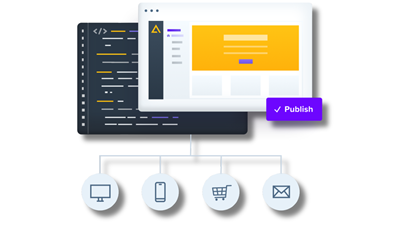A Complete Guide to Content Governance


Businesses of all sizes now understand the value of producing high-quality content in the digital age. Companies spend a lot of money creating and releasing relevant, captivating, and educational material to draw in, engage, and convert their target audience. Content is the foundation of any successful digital marketing campaign.
Maintaining quality, consistency, and brand identity across all media is difficult for organizations as they continue to produce and publish more content. A procedure that guarantees material is accurate, consistent, and adheres to brand rules is called content governance in this situation.
What is Content Governance?
Managing material from creation to publication and beyond is known as content governance.
Businesses with a significant volume of content, a distributed content creation team, or various channels and platforms must have effective content governance. Companies can increase content quality, maintain consistency across all platforms, and streamline the content development process using content governance.
What is a Content Governance Model?
A content governance model structure explains the company's steps to control its content. It explains the tools and processes used to manage content, the content development team's roles and duties, and the material's quality criteria.
A content governance model offers a precise and organized method for producing information, guaranteeing that it is correct, consistent, and serves the organization's objectives. Additionally, it aids organizations in proactively identifying and mitigating content-related hazards.

Why is Content Governance Important?
There are several reasons why content governance is crucial. First, it ensures the material is correct, consistent, and aligned with the company's objectives and brand image. Maintaining a solid brand image and reputation depends on this.
Second, content governance aids companies in streamlining the production of content, saving time and money. Also, it lessens the possibility of content faults and inconsistencies, which can harm the brand's reliability and dependability.
Lastly, for compliance reasons, content governance is crucial. With stringent data security and privacy guidelines, content governance ensures companies comply with all applicable rules and laws.
How is Content Governance Different from Content Strategy?
Although they are closely related, content governance and content strategy are two distinct ideas. The planning and implementation of a content marketing strategy to meet specific company objectives are known as content strategy. It includes deciding on the target market, producing content, and choosing distribution platforms and channels.
The goal of content governance, on the other hand, is to manage material over its entire existence. Ensuring that material adheres to quality standards, is consistent, and supports the organization's objectives and brand identity entails developing and implementing policies and procedures.
Content governance ensures that the material is consistent across all platforms and aligned with the organization's goals and brand identity. In contrast, content strategy determines what content to produce and where to distribute it.
How does Content Governance Help Your Content Strategy?
Any content strategy's success depends on effective content governance. It ensures that the content adheres to the organization's goals and brand identity and is truthful and consistent. As a result, the content produced will be more successful at drawing in and retaining the target audience, boosting conversion rates, and enhancing the business's reputation.
The proactive mitigation of content-related risks is assisted by content governance. This involves ensuring adherence to pertinent rules and regulations, eliminating content mistakes and inconsistencies, and minimizing the chance of reputational harm from low-quality material.
Putting a content governance strategy into practice necessitates a systematic approach involving various stakeholders, procedures, and technologies. The actions listed below can assist firms in developing and putting into practice an efficient content governance strategy:
- Determine the scope and goals of the content governance strategy. This includes deciding on the strategy's objectives and defining the strategy's area, including the teams, procedures, and content categories covered.
- Create content policies and guidelines: Developing policies and procedures for producing, managing, and maintaining material is a critical component of content governance. These policies should all consider the brand voice, tone, messaging, and legal obligations, aligning with the entire content strategy.
- Give roles and responsibilities: It's crucial to specify who will be responsible for what aspects of content development, management, and upkeep. This includes defining who is accountable for what parts of the content lifecycle, such as creation, approval, publication, and retirement, and assigning ownership.
Technology platforms are called content governance systems to assist enterprises in efficiently managing their content governance processes. These systems include several capabilities, such as content audits, workflow management, content lifecycle management, and access control, to enable content governance. Organizations may automate and streamline their content governance procedures using content governance solutions, which lowers the likelihood of mistakes, inconsistency, and inefficiency.
Agility & Content Governance
Agility is a composable, API-first content platform created to satisfy the specific content needs of contemporary digital organizations. Since all content is kept in one location, there is less chance of duplication, inconsistencies, or errors, making it simpler to apply content governance measures.
One of its main advantages is the Agility content platform's versatility in managing content governance. The ability to design and manage content types, fields, and workflows allows for granular content management.
Governance rules can be applied to particular content types to ensure that each material form is maintained consistently and under control. This is especially helpful for companies with complex content needs, such as those in highly regulated industries. Agility's platform reduces the risk of non-compliance and associated legal or reputational difficulties by ensuring that all material is developed and handled by legal and regulatory requirements.
Agility's platform has robust user management tools that let firms restrict access to particular content categories or locations, assuring that only authorized members may see, edit, or publish material. In general, Agility's API-first, composable content platform is intended to assist businesses in implementing effective content governance strategies, guaranteeing that all material is developed, managed, and published uniformly and regulated manner.

About the Author
Harmonie is the Senior Marketing Manager at Agility CMS
View Related Resources

What is Content Architecture & Why It's Important

How to Build a Content Governance Workflow That's Right For You

